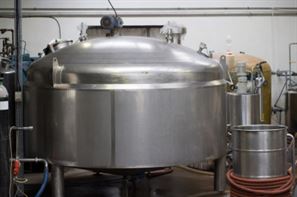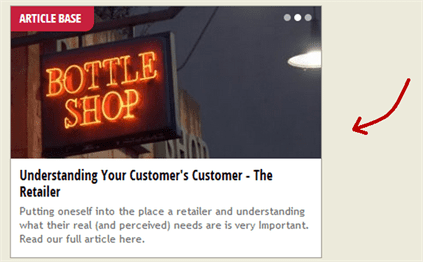Report On Cider Consumption Globally
Consumption of this beverage has increased by 50% in the past decade. In addition to courting emerging cider markets such as the US, there remains significant room for expansion in the UK (the most developed cider market) where demographics and consumer preferences look set to support further increases in cider sales
According to Robobank report, Cider was traditionally a very small beverage category, but in the past ten years the industry has undergone a period of rapid expansion, posting an impressive average annual volume growth rate of 6%.
(Image of Cider Brewing Tank)
 In volume terms, cider is only about 1 percent of the beer market, but prices are much higher.
In volume terms, cider is only about 1 percent of the beer market, but prices are much higher.
According to Chicago tribune news, The United States accounts for about a fifth of global beers sales of $500 billion a year, so each percentage increase there for cider could add well over $1 billion to the total revenue one Heineken and number two C&C.
Beer consumption in Europe and North America has been in decline for years and is expected to keep falling. “Mass-produced beer have suffered due to the surge of craft beers in the U.S. Big Brewers feed the threat. (as per Rueters)
This year MillerCoors has acquired the third largest U.S. cider product Crispin, and Ireland´s C&C Group, maker of Magners, has bought Vermont Hard Cider Company, which makes the leading U.S. brand Woodchuck.
Amheuser-Busch InBev, the world´s number one beer maker, launched Michelob Ultralight Cider in the United States in Spring, a year after its Stella Artois Cider hit the market in Britain. Angry Orchard, a unit of craft brewer Boston Beer Co, went nationwide at the same time.
Heineken with 24 percent of the market, this year bought a Belgian cider innovation center and said it would take back U.S. distribution right for top selling Strongbow from Vermont Hard cider from 2013. In Britain, the sector grew 24 percent in volume terms from 2006 to 2011, according to market research group Mintel over the same period, beer sales have fallen 23 percent.
Sales are expected to rise 12 percent from 2011 to 2016, says Mintel and by 29 percent, or 5.2 percent a year, according to Euromonitor.
Rabobank analyst Francois Sonneville: "55% cider drinkers are women, most of whom are under 30 years of age. This so-called female millennial is the demographic most likely to exhibit hybrid consumer behavior, in which people eschew mid-market options in favour of brands at the extreme end of the product spectrum, switching between super-premium and value options as the occasion demands. The premium and mainstream cider brands that currently dominate the sector will need to differentiate themselves or risk losing share. These companies would be well-advised to follow the example of major US brewers and invest in the super-premium segment at an early stage."
It sees UK beer sales down 9 percent in that period, while Britain represents almost half of the 1.8billion liters drunk globally last year, the United States is almost virgin territory, Americans drank just 59 million liters last year, 15 times less than Britons in a country with five times more people. Cider made up 0.3 percent of beer market volume. That small base is growing fast, with ciders branding themselves as a healthier alternative-made from apples and free from gluten-and appealing to the sweeter palates of young people there.
Figures from the consumer analysts Mintel show cider has bucked the economic climate that saw many lager brands including Carlsberg and Heineken report flat UK sales in 2012. Three in five adults now drink cider, a 47 per cent increase on the figure in 2011. While it still trails beer, which is drunk by 70 per cent of Britons, cider is consumed by a greater number of adults than spirits (57 per cent).
.jpg)
(Image: Cider Bottling)
Cider sales have soared 32 per cent between 2007 and 2012 to reach £2.7bn, with sales increasing 5 per cent in the last year alone. Volume sales have posted slower growth, although the market still managed overall growth of 18 per cent over the same period. Over the next five years Mintel predicts the category will reach sales of £3.7bn, driven partly by duty increases and rising brand awareness.
Chris Wisson, senior drinks analyst at Mintel says brewers need to invest more in the premium end of the market to reap “spectacular rewards”. Areas ripe for product development include the premium end of the market with more emphasis on medium and dry cider to boost daily consumption rates and attract older drinkers, he adds.
Just 8 per cent of Britons think that cider is sophisticated, while only 14 per cent believe that it is worth paying more for, both of which are behind the associations with wine.
Research from Nielsen says 38 percent of U.S. cider drinkers are under 35 years old, against 17.5 percent for beer, and half earn $70.000 or more, against 38 percent for beer.
A 24 bottle case of premium light beers retails for about $20. Craft beer and cider normally cost at least 30. If cider can also match craft beer´s 7 percent of the U.S. market, that would spell a lot of high-margin growth.
Euromonitor expects U.S. cider sales to grow 10.6 percent on average, or 65 percent overall, from 2011 to 2016, with beer as a whole down 1 percent. It also sees strong growth in South Africa, the world´s second largest market, with 48 percent expansion over the five years to 2016.
The arrival of Carling and Somersby in the UK cider market is one of the factors that should boost the industry. The marketing investment should raise the noise level of the category and improve its profile. The involvement of Molson Coors, Carlsberg and recently Fullers is an endorsement of the future prospects of the category. The outlook for ciders in United Kingdom has been dramatically improved now that the threat from minimum pricing has been removed. Government estimates suggested that the cider market would nearly be halved if the policy was introduced.
The key segment movement in 2012 was the rise of flavored cider, which has now overtaken the pear segment to make up around a tenth of the market. The launch of Stella Cider pear and Strongbow Pear more than compensated for the fall in other branded pear offerings and pear share did increase last year, standing at almost 9% of the market. Apple continues to dominate but has dropped to little more than 80%. Until recently the market was split between the dry apple ciders popular in the West Country and the sweet apple ciders enjoyed in the North East. The dry ciders make up the bulk of sales. The arrival of Kopparberg reignited the pear segment (or what industry purists would call perry) and its success prompted Magners, Bulmers, Stella Cidre and Strongbow among others to introduce pear variants. When Kopparberg began to enjoy phenomenal success with other flavors, the big players followed suit culminating in the jump in flavored ciders in 2012.
Australia Cider Market Insights 2013
According to RnR Market research, The outlook for cider market in Australia remains positive, with growth in 2013 expected to continue at high double-digit rates. Given the nature of the cider industry in Australia, Private Label cider involvement is based on retailers' Private Label beer strategies, with cider considered an increasingly important part of a wider Private Label beer portfolio. The research Australia Cider Market Insights 2013 says, traditionally, Private Label was not an important part of the Australian alcoholic drinks market. Retailer brands had tended to be clones of branded products, solely differentiated by price, and sales uptake was mediocre. However, this has changed significantly in recent years, with the two leading retailers both investing in launching owned and captive beer and cider brands across the price spectrum as they seek to gain a larger share of the market. Australia's leading supermarket chains, Woolworths and Coles, dominate both off-trade and on-trade alcohol retail through supermarket outlets and standalone specialist stores. In the early 2010s, both supermarkets announced their intention to significantly raise Private Label (including captive label) sales, with Woolworths targeting a doubling of its Private Label share across all grocery categories. Initial signs from the beer and cider markets suggest that this is going well, with noticeable enhancement and differentiation occurring in both retailers' ranges.
Cider New Flavors
Innovation is a key factor in cider´s present and expected growth. New flavors have also helped expand cider´s appeal beyond middle-aged men to younger men and women and have made it an all season beverage, as mentioned in an article published by Rueters.
In Britain, where cider need contain no more than 25 percent apple juice, shop sales of fruit-flavored ciders have grown by 80 percent in the past year, with addition of ginger, honey, rhubarb, cloudberries, red berries or lime.
What happened in France? Well, here drinks made exclusively from apples can be called cider, is the only major market in which cider sales are forecast to fall in the 2011-2016 period, according to Euromonitor, which sees an overall 8 percent decline there.
Until Strongbow´s U.S. entry in 2003, U.S cider was almost exclusively high strength and sold in large bottles. Now smaller bottles, can and boxes have made it an easier drink in bars and at home.
U.S Cider market has experienced phenomenal growth rates over the past few years. However, as the initial excitement over the drink lessens, the growth of the market will slow. Cider growth rates will remain in the double digits moving forward. Boston Beer (Angry Orchard) continues to attack the market aggressively, pushing their product onto shelves. They introduced Angry Orchard in 2011, offering three styles: crisp apple, apple ginger and traditional dry. This growth is expected to continue, increasing volumes by another 65% in 2013. This makes Angry Orchard the fastest growing brand in the market.
Woodchuck led the U.S market with $38.6 million in sales in 2012. This was a 40% increase over 2011 sales and is expected to grow 5% in 2013. In late 2012, C&C Group acquired Vermont Hard Cider. The research USA Cider Market Insights 2013 says Hornsby´s, owned by C&C Group and is the number three brand in the market. Its line includes Hard Crisp Cider, Hard Strawberry Lime and Hard Amber Cider. Hornsby´s, which has been one of the top three brands for the past few years, experienced a 9% decline across its product range in 2012 compared to 2011 due to confusion over pack types (switch to 33 cl bottles) and a previous lack of producer focus. (Source: PR Newswire)
Super-premium cider companies face more cost disadvantages than microbreweries according to Rabobank, when compared to mainstream rivals; limited scalability, lack of tax breaks and low availability of fruit all result in higher costs, which are hard to pass on to consumers in markets where cider is only just emerging. It is also difficult for the value segment to establish a cost advantage versus mainstream brands because of the strict regulation around the minimum fruit content which results in high input costs.
Despite these hurdles, the super-premium and value end segments are predicted to outgrow mainstream offerings in the long-term. The international premium brands that dominate the present market run the risk of getting stuck in the middle. Mainstream players that react early to the hybrid consumer trend, developing their own super-premium products and investing in strong branding should continue to flourish, facilitating the future growth of the cider industry.
References and Sources Used: Euromonitor, Rabobank Report, Mintel, PR Newswire, Reuters

